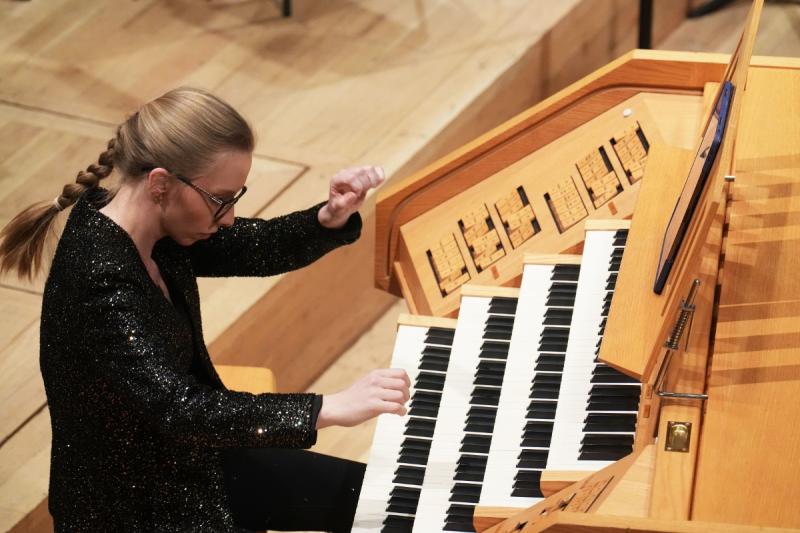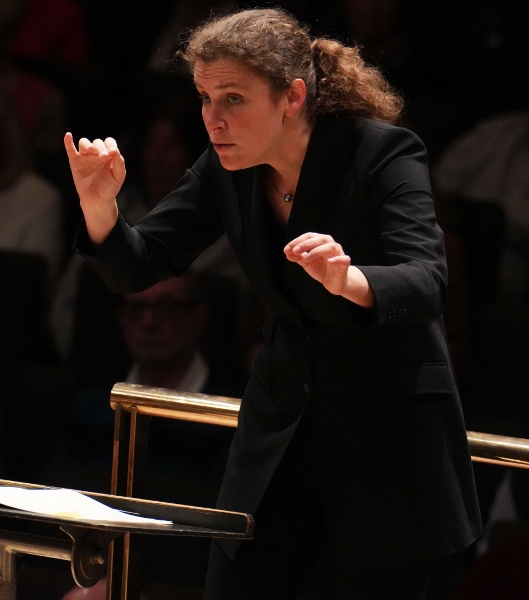Lapwood, Hallé, Niemeyer, Bridgewater Hall, Manchester review - light and fiery Poulenc concerto | reviews, news & interviews
Lapwood, Hallé, Niemeyer, Bridgewater Hall, Manchester review - light and fiery Poulenc concerto
Lapwood, Hallé, Niemeyer, Bridgewater Hall, Manchester review - light and fiery Poulenc concerto
A varied evening with a star organist – and a world premiere

“Let the organ thunder!” is the sentiment a lot of us will associate with an orchestral concert featuring the king of instruments. The Hallé’s programme with Anna Lapwood as soloist (repeating, from her BBC Proms debut with them in 2021, the Saint-Saëns “Organ” Symphony) seemed designed to evoke that thought.
But the organ in the Bridgewater Hall isn’t exactly made for thundering. Big Bertha it is not. What it is really good at is a light, clear and sometimes fiery sound – ideal for Poulenc’s 1939 Organ Concerto, which was the undoubted highlight of the evening.
There was light and airy French music to begin with from the orchestra alone, conducted by Corinna Niemeyer in her debut with the Hallé. That was auspicious: she got a gentle but precise pizzicato underlay from the start for the beautiful tune of Fauré’s Pavane, controlled the ends of its phrases delightfully, and made the violas charmingly audible in the central section.
Then it was time for Anna Lapwood and the Poulenc. There isn’t anything else quite like it in the repertoire: it makes the organ dance and sing, and when it brashly references Bach’s Fantasia in G minor you’re never quite sure whether it’s a send-up or a tribute.
 The gentler passages are full of the characteristic sounds of the classic 19th-century French organ – with help from the great organist-composer Maurice Duruflé, Poulenc specified exactly which ones he wanted us to hear – and Thomas Trotter, its original consultant, designed the Bridgewater Hall organ to have them too. Anna Lapwood followed these instructions fastidiously. They were all there: flûte, cor de nuit, clarinette, nazard, quintaton, octavin, gambe and voix celeste, with the choruses in full body and the reeds rasping out among them. It was fun and it was exemplary, and the orchestra’s contribution, with expressive violins (led by Peter Liang) and a lovely viola solo from Timothy Pooley, was finely judged and sympathetic.
The gentler passages are full of the characteristic sounds of the classic 19th-century French organ – with help from the great organist-composer Maurice Duruflé, Poulenc specified exactly which ones he wanted us to hear – and Thomas Trotter, its original consultant, designed the Bridgewater Hall organ to have them too. Anna Lapwood followed these instructions fastidiously. They were all there: flûte, cor de nuit, clarinette, nazard, quintaton, octavin, gambe and voix celeste, with the choruses in full body and the reeds rasping out among them. It was fun and it was exemplary, and the orchestra’s contribution, with expressive violins (led by Peter Liang) and a lovely viola solo from Timothy Pooley, was finely judged and sympathetic.
The Hallé’s artist-in-residence, Dobrinka Tabakova, was the writer of the organ solo work which opened the second part of the concert, in a kind of joint world premiere performance (as the entire programme is duplicated this week) of Sanctus from Orbis Factor, one of a set of 12 pieces commissioned and curated by Anna Lapwood. It was a product of lockdown, the soloist said in a brief introduction, when “we worked on it together”, and like all the pieces in the collection (titled Gregoriana) it’s based on a Gregorian chant melody. Tabakova made it to explore the variety of an organ’s sounds, from transparent and floating to earthy and rich, and it did exactly that, gradually adding to the tonal palette through to a triumphant major-third ending.
The work that gave this concert programme its title, and the longest on the list, came last. I’ve always been a bit puzzled as to why Saint-Saëns’ “Organ” Symphony (no. 3 in C minor) seems such a box-office draw. I guess it’s partly because he hammers away at his tunes and their variants so much that you really have them like ear-worms in your head by the time it’s over – and partly that we in England (it was written for the English) love the noise that music makes. There aren’t many works that make more noise than the Organ Symphony.
There was, glad to relate, more than just noise in this performance. Corinna Niemeyer (pictured above) worked up tension in the first movement and drew some full-throated and brassy climaxes. Thde slow movement was warmly and emotionally articulated, and in the scherzo-like third the switches of tempo were pretty neatly negotiated, with the ’s oboe and clarinet solos elevating the discourse with necessary crispness. Tension built again effectively towards the end, as Saint-Saëns gives us the crescendo to beat all crescendos. I was hoping for the Bridgewater Beast to be unleashed by Anna Lapwood just a little more freely for its final moment of glory – but then you can’t always have everything you wish for.
rating
Share this article
The future of Arts Journalism
You can stop theartsdesk.com closing!
We urgently need financing to survive. Our fundraising drive has thus far raised £49,000 but we need to reach £100,000 or we will be forced to close. Please contribute here: https://gofund.me/c3f6033d
And if you can forward this information to anyone who might assist, we’d be grateful.

Subscribe to theartsdesk.com
Thank you for continuing to read our work on theartsdesk.com. For unlimited access to every article in its entirety, including our archive of more than 15,000 pieces, we're asking for £5 per month or £40 per year. We feel it's a very good deal, and hope you do too.
To take a subscription now simply click here.
And if you're looking for that extra gift for a friend or family member, why not treat them to a theartsdesk.com gift subscription?
more Classical music
 Robin Holloway: Music's Odyssey review - lessons in composition
Broad and idiosyncratic survey of classical music is insightful but slightly indigestible
Robin Holloway: Music's Odyssey review - lessons in composition
Broad and idiosyncratic survey of classical music is insightful but slightly indigestible
 Bizet in 150th anniversary year: rich and rare French offerings from Palazzetto Bru Zane
Specialists in French romantic music unveil a treasure trove both live and on disc
Bizet in 150th anniversary year: rich and rare French offerings from Palazzetto Bru Zane
Specialists in French romantic music unveil a treasure trove both live and on disc
 Scottish Chamber Orchestra, Ibragimova, Queen’s Hall, Edinburgh review - rarities, novelties and drumrolls
A pity the SCO didn't pick a better showcase for a shining guest artist
Scottish Chamber Orchestra, Ibragimova, Queen’s Hall, Edinburgh review - rarities, novelties and drumrolls
A pity the SCO didn't pick a better showcase for a shining guest artist
 Kilsby, Parkes, Sinfonia of London, Wilson, Barbican review - string things zing and sing in expert hands
British masterpieces for strings plus other-worldly tenor and horn - and a muscular rarity
Kilsby, Parkes, Sinfonia of London, Wilson, Barbican review - string things zing and sing in expert hands
British masterpieces for strings plus other-worldly tenor and horn - and a muscular rarity
 From Historical to Hip-Hop, Classically Black Music Festival, Kings Place review - a cluster of impressive stars for the future
From quasi-Mozartian elegance to the gritty humour of a kitchen inspection
From Historical to Hip-Hop, Classically Black Music Festival, Kings Place review - a cluster of impressive stars for the future
From quasi-Mozartian elegance to the gritty humour of a kitchen inspection
 Shibe, LSO, Adès, Barbican review - gaudy and glorious new music alongside serene Sibelius
Adès’s passion makes persuasive case for the music he loves, both new and old
Shibe, LSO, Adès, Barbican review - gaudy and glorious new music alongside serene Sibelius
Adès’s passion makes persuasive case for the music he loves, both new and old
 Anja Mittermüller, Richard Fu, Wigmore Hall review - a glorious hall debut
The Austrian mezzo shines - at the age of 22
Anja Mittermüller, Richard Fu, Wigmore Hall review - a glorious hall debut
The Austrian mezzo shines - at the age of 22
 First Person: clarinettist Oliver Pashley on the new horizons of The Hermes Experiment's latest album
Compositions by members of this unusual quartet feature for the first time
First Person: clarinettist Oliver Pashley on the new horizons of The Hermes Experiment's latest album
Compositions by members of this unusual quartet feature for the first time
 Gesualdo Passione, Les Arts Florissants, Amala Dior Company, Barbican review - inspired collaboration excavates the music's humanity
At times it was like watching an anarchic religious procession
Gesualdo Passione, Les Arts Florissants, Amala Dior Company, Barbican review - inspired collaboration excavates the music's humanity
At times it was like watching an anarchic religious procession
 Classical CDs: Camels, concrete and cabaret
An influential American composer's 90th birthday box, plus British piano concertos and a father-and-son duo
Classical CDs: Camels, concrete and cabaret
An influential American composer's 90th birthday box, plus British piano concertos and a father-and-son duo
 Cockerham, Manchester Camerata, Sheen, Martin Harris Centre, Manchester review - re-enacting the dawn of modernism
Two UK premieres added to three miniatures from a seminal event of January 1914
Cockerham, Manchester Camerata, Sheen, Martin Harris Centre, Manchester review - re-enacting the dawn of modernism
Two UK premieres added to three miniatures from a seminal event of January 1914
 Kempf, Brno Philharmonic, Davies, Bridgewater Hall, Manchester review - European tradition meets American jazz
Bouncing Czechs enjoy their Gershwin and Brubeck alongside Janáček and Dvořák
Kempf, Brno Philharmonic, Davies, Bridgewater Hall, Manchester review - European tradition meets American jazz
Bouncing Czechs enjoy their Gershwin and Brubeck alongside Janáček and Dvořák

Add comment